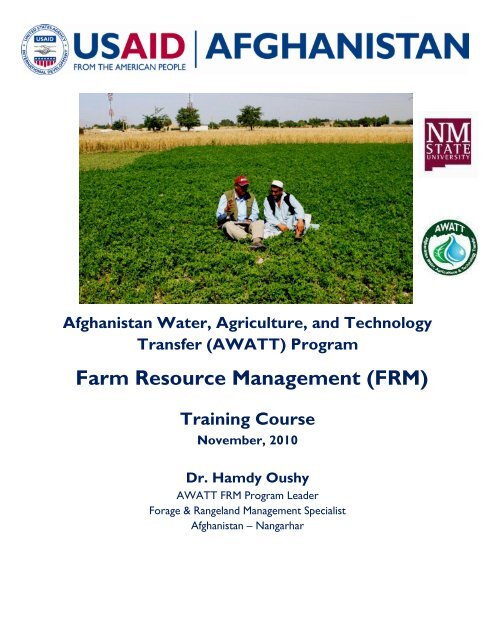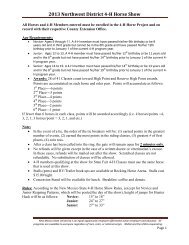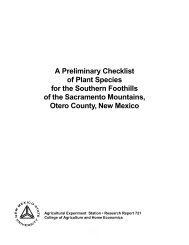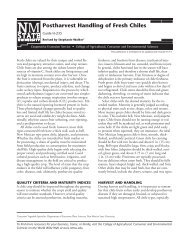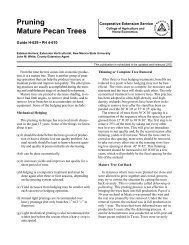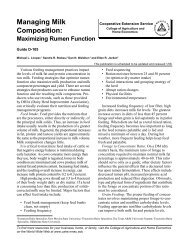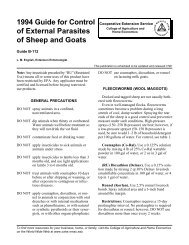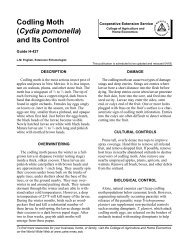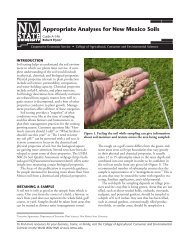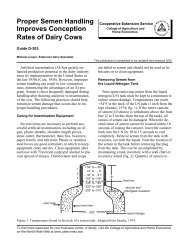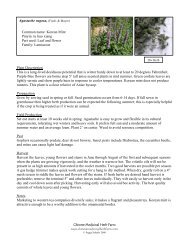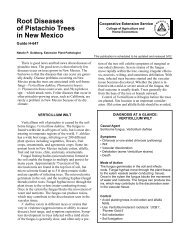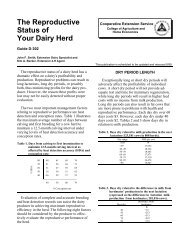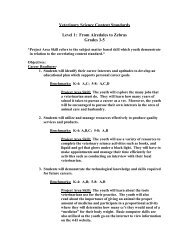Farm Resource Management (FRM) - College of Agricultural ...
Farm Resource Management (FRM) - College of Agricultural ...
Farm Resource Management (FRM) - College of Agricultural ...
You also want an ePaper? Increase the reach of your titles
YUMPU automatically turns print PDFs into web optimized ePapers that Google loves.
Afghanistan Water, Agriculture, and TechnologyTransfer (AWATT) Program<strong>Farm</strong> <strong>Resource</strong> <strong>Management</strong> (<strong>FRM</strong>)Training CourseNovember, 2010Dr. Hamdy OushyAWATT <strong>FRM</strong> Program LeaderForage & Rangeland <strong>Management</strong> SpecialistAfghanistan – Nangarhar
AWATT <strong>Farm</strong> <strong>Resource</strong> <strong>Management</strong> Training ManualAuthorityPrepared for USAID/Afghanistan under Cooperative Agreement No. 306-A-00-08-00506awarded 03 March 2008, entitled Afghanistan Water, Agriculture and Technology Transfer(AWATT).This document was completed in partial fulfillment <strong>of</strong> Clause 2a <strong>of</strong> the Award Document forCooperative Agreement No. 306-A-00-08-00506 awarded 03 March 2008, entitled AfghanistanWater, Agriculture and Technology Transfer (AWATT). The views expressed and opinionscontained in this report are those <strong>of</strong> the NMSU AWATT team and are not intended asstatements <strong>of</strong> policy <strong>of</strong> USAID.Prepared by:NMSU-AWATT Team with CSU, UIUC, and SIUCCreditsThe program referred to in this document is based on the NMSU-AWATT Technical Proposal, asrevised, submitted February 4, 2008 in response to USAID Request for Application No. 306-07-020Afghanistan Water, Agriculture and Technology Transfer Programi
AWATT <strong>Farm</strong> <strong>Resource</strong> <strong>Management</strong> Training ManualTABLE OF CONTENTSTable <strong>of</strong> Figures ................................................................................................................................................ iiiFARM RESOURCE MANAGEMENT (<strong>FRM</strong>)................................................................................................. 1PROGRAM FOCUS AND BENEFITS .............................................................................................................. 1<strong>FRM</strong> Concept................................................................................................................................................. 1Introduction ................................................................................................................................................... 2Rationale for Project .................................................................................................................................... 5Description <strong>of</strong> Project ................................................................................................................................. 5Analysis <strong>of</strong> Project ........................................................................................................................................ 6<strong>FRM</strong> FOCUS ...................................................................................................................................................... 7Strategies to Restore <strong>Agricultural</strong> <strong>Farm</strong> Diversity ................................................................................ 8<strong>FRM</strong> Objectives ............................................................................................................................................. 8<strong>FRM</strong> Benefits for <strong>Farm</strong>ers ........................................................................................................................... 9CHAPTER 1: AGROECOLOGY AS THE FUNDAMENTAL SCIENTIFIC BASIS FOR <strong>FRM</strong> .............. 10Building on Traditional Knowledge ........................................................................................................ 10The Science <strong>of</strong> Agroecology ................................................................................................................... 10Agroecosystem Processes Optimized through the Use <strong>of</strong> Agroecological Technologies ........ 11Enhancing Productivity through Multi-Species Agroecosystems .................................................... 11Healthy Soils – Healthy Plants ................................................................................................................ 12Examples <strong>of</strong> Multifunctional Agroecological Technologies .............................................................. 12Self-Sufficiency ............................................................................................................................................ 13Elements <strong>of</strong> an Appropriate <strong>FRM</strong> Strategy .......................................................................................... 13Requirements <strong>of</strong> a Pro-Poor <strong>FRM</strong> Strategy ......................................................................................... 13Integration <strong>of</strong> Soil and Pest <strong>Management</strong> Practices ........................................................................... 13CHAPTER 2: SOIL ......................................................................................................................................... 14Addition <strong>of</strong> Organic Matter ..................................................................................................................... 15Cover Crops Can Stabilize Soil .............................................................................................................. 16Cover Crops Provide More than Nitrogen Cycling .......................................................................... 17Leguminous Cover Crops Can Add Nitrogen through Nodulation .............................................. 17CHAPTER 3: IRRIGATION ........................................................................................................................... 18Potential Benefits <strong>of</strong> Irrigation Water <strong>Management</strong> .......................................................................... 18CHAPTER 4: CROP ROTATION ................................................................................................................ 20Conservation Crop Rotation .................................................................................................................. 20Practical Functionality ............................................................................................................................... 20Pest Control ............................................................................................................................................... 21Afghanistan Water, Agriculture and Technology Transfer Programii
AWATT <strong>Farm</strong> <strong>Resource</strong> <strong>Management</strong> Training ManualDisease Control ......................................................................................................................................... 21Insect Control ............................................................................................................................................ 21Weed Control ............................................................................................................................................ 22Soil Nitrogen ............................................................................................................................................... 22Soil Tilth and Structure ............................................................................................................................ 22Soil Moisture ............................................................................................................................................... 23Reduction <strong>of</strong> Soil Erosion ........................................................................................................................ 23Allelopathy .................................................................................................................................................. 23Monitoring and Possible Redesign <strong>of</strong> Rotation ................................................................................... 23CHAPTER 5: FORAGE LEGUME ................................................................................................................. 24CHAPTER 6: INTEGRATED CROP-LIVESTOCK FARMING SYSTEM ................................................. 25Diversified vs. Integrated Systems ......................................................................................................... 26Advantages and Constraints <strong>of</strong> the System ......................................................................................... 27Key Principles ............................................................................................................................................. 29Lessons Learned and Recommendations ............................................................................................. 29Key Issues/Questions for Project Design ............................................................................................. 30CHAPTER 7: RURAL COMMUNITY PARTICIPATION .......................................................................... 32Definitions ................................................................................................................................................... 32CHAPTER 8: MONITORING AND EVALUATION OF THE <strong>FRM</strong> ......................................................... 33<strong>FRM</strong> Model in the Lower Watershed Areas <strong>of</strong> Nangarhar ............................................................. 33CHAPTER 9: FARM ENTERPRISE ............................................................................................................... 35Introduction ................................................................................................................................................ 35Diversification <strong>of</strong> <strong>Farm</strong> Enterprises and the Increased Need to Produce for the Market........ 35Need for Improved <strong>Management</strong> and Business Skills to Increase Pr<strong>of</strong>its and <strong>Farm</strong> Income.... 36Definition <strong>of</strong> a <strong>Farm</strong> .................................................................................................................................. 36CHAPTER 10: FARM MANAGEMENT ....................................................................................................... 39Definition <strong>of</strong> <strong>Farm</strong> <strong>Management</strong> ............................................................................................................. 39<strong>Farm</strong>er as a Manager Needs New Skills ............................................................................................... 39Functions <strong>of</strong> <strong>Farm</strong> <strong>Management</strong> ............................................................................................................. 40Further Reading .............................................................................................................................................. 41Sources <strong>of</strong> Information and Examples <strong>of</strong> Best Practice............................................................................ vTABLE OF FIGURESFigure 1 Key aspects <strong>of</strong> an integrated crop-livestock farming system. ....................................................... 26Figure 2 Phases <strong>of</strong> <strong>Farm</strong> <strong>Management</strong> .......................................................................................................... 40Afghanistan Water, Agriculture and Technology Transfer Programiii
AWATT <strong>Farm</strong> <strong>Resource</strong> <strong>Management</strong> Training ManualFARM RESOURCE MANAGEMENT (<strong>FRM</strong>)PROGRAM FOCUS AND BENEFITS - <strong>FRM</strong> CONCEPTA sustainable cropping system is an essential part <strong>of</strong> a complete farming system <strong>of</strong> soil, water,air, plant, animal, and human resources. Considering how the farm fits into broader watershedmanagement (e.g. <strong>of</strong>f-site effects and resource opportunities) is also fundamental to problemposingand problem-solving, resource management success, and development <strong>of</strong> sustainablecommunities.We should focus on understanding and improving soil quality, water quantity/quality, air quality,nutrient and salinity management, crop yield and quality, irrigation/water management, andintegrated pest management. In addition, we should concentrate on reducing overall on-farmenergy use, inputs, production costs, pest incidences, pumping costs, and soil and water losses.The key approach to achieving integrated sustainable management is to think system(ecosystem, whole farm, and watershed), think critically (connect the dots), actively seekresource opportunities, emphasize technology ―exchange‖ vs. ―transfer‖ with other producersand partners, plan creatively and flexibly, and focus on keeping energy flow through theintegrated system. A reemphasis on biological factors is also necessary since recent agriculturehas essentially forgotten biological processes, but rather focused on chemical and physicalfactors. Improving soil quality is a key to improving soil, water, air, plant, and animal resources.Case studies, field trials, and demonstrations are all important approaches for technologyexchange. Interdisciplinary teams including producers and partners are necessary to developintegrated sustainable farming systems.We must utilize holistic approaches to management <strong>of</strong> soil and water resources. Integration <strong>of</strong>needed conservation practices and management schemes assures critical resource concerns areaddressed and water quality, soil quality, and overall ecosystem health is maintained orimproved. Considering how the farm fits into broader watershed management is also essentialto ‗problem-posing and solving‘ to ensure resource management success.Now is a critical time to implement management schemes to protect long-term soilsustainability. Global reduction in agricultural productivity due to soil erosion and degradation,depletion <strong>of</strong> irrigation water supplies, and competing land uses is putting a squeeze on capacityto meet increasing world-wide demand for food and fiber. Couple this with the economicchallenges posed by the high cost <strong>of</strong> fossil fuels and derived products, such as fertilizers, andstruggling farm economies, and it becomes clear that the continued success <strong>of</strong> agriculturalsystems is dependent upon our ability to maintain soil health and manage water resourcesthrough holistic approaches in conservation planning.In order to benefit the poor more directly, a <strong>Farm</strong> <strong>Resource</strong> <strong>Management</strong> (<strong>FRM</strong>) approachmust be applicable under the highly heterogeneous and diverse conditions in which smallholderslive; it must be environmentally sustainable and based on the use <strong>of</strong> local and indigenousresources. The emphasis must be on improving whole farming systems at the field or watershedlevel rather than specific commodities. Technological generation must be demand-driven, whichAfghanistan Water, Agriculture and Technology Transfer Program 1
AWATT <strong>Farm</strong> <strong>Resource</strong> <strong>Management</strong> Training Manualmeans that research priorities must be based on the socio-economic and environmental needsand circumstances <strong>of</strong> resource-poor farmers (Blauert and Zadek, 1998).The study ‖An Agroecological Basis for Natural <strong>Resource</strong> <strong>Management</strong> Among Poor <strong>Farm</strong>ers inFragile Lands‖ prepared by Miguel A. Altieri (2005), indicated that food security in thedeveloping world will clearly need to be increased, especially in the marginal areas where themajority <strong>of</strong> the poor people are concentrated. In order to benefit the poor more directly, anew <strong>Farm</strong> <strong>Resource</strong> <strong>Management</strong> (<strong>FRM</strong>) approach must be developed to directly andsimultaneously tackle the following objectives:Poverty alleviation;Food security and self reliance;Ecological management <strong>of</strong> productive farming system;Empowerment <strong>of</strong> rural communities.INTRODUCTIONWe will explore the problem <strong>of</strong> crop rotation in Afghanistan, and discuss possible remedies andsolutions using the <strong>FRM</strong> approach.New approaches to enhance productivity must depart from the intensive inputs <strong>of</strong> the GreenRevolution and use resource-conservation technologies. The use <strong>of</strong> such technologies, forexample, the incorporation <strong>of</strong> legumes in rotation schemes, can enhance the sustainability <strong>of</strong>agroecosystems in many rural areas (Lappe et al., 1998).A sustainable agricultural development strategy that enhances the environment must be basedon agroecological principles. Attention focused on the linkages between agriculture and naturalresource management will be <strong>of</strong> great help in solving the problems <strong>of</strong> poverty, food insecurityand environmental degradation (Altieri et al., 1998).The On-<strong>Farm</strong> <strong>Resource</strong> <strong>Management</strong> (<strong>FRM</strong>) approach that USAID/DAIL/AWATT havelaunched in Nangarhar province, Afghanistan, will demonstrate the best model to tackle theproblems <strong>of</strong> soil degradation, low organic matter, low water holding capacity, low productivity,weeds, disease, and insects. We need to break the cycle <strong>of</strong> wheat/rice to solve these problems.In Afghanistan, the main problems with the wheat/rice intensive crop rotation system are:both crops are grasses, so they do not add any organic matter to the soil;both crops only use the top 30 cm <strong>of</strong> the soil, where they have shallow root systems, sothe top 30 cm <strong>of</strong> the soil has been depleted and degraded;Afghan farmers do not to return animal manure to the soil; instead, the majority use themanure for fuel purposes.Afghanistan Water, Agriculture and Technology Transfer Program 2
AWATT <strong>Farm</strong> <strong>Resource</strong> <strong>Management</strong> Training ManualWheat/ Rice Intensive Crop RotationRice/wheat intensive crop rotation in BaghlanProvince on May 25, 2009; above, the wheat fieldwas close to maturity and harvest; below, the ricenursery contained seedlings to replace the wheatafter harvest in June.Wheat/rice intensive crop rotation in BaghlanProvince on November 18, 2009; right, rice fieldshad been harvested and were ready to be plowedfor the planting <strong>of</strong> winter wheat; left, a germinatedwheat field had already replaced rice.Afghanistan Water, Agriculture and Technology Transfer Program 3
Problems <strong>of</strong> Wheat/Rice Crop Rotation in AfghanistanAWATT <strong>Farm</strong> <strong>Resource</strong> <strong>Management</strong> Training ManualSoil Problems:Salinity accumulation on soil due to lack <strong>of</strong> propercrop rotation and proper farm management.Weed Problems (Wild Oats):Wild oats have invaded a wheat field due to lack <strong>of</strong>crop rotation with Egyptian clover.Weed Problems (Dodder Weeds):Dodder weed has invaded farms due to lack <strong>of</strong>proper crop rotation and farm management.Intensive wheat/rice crop rotation.The Green Revolution with its intensive inputs maynot work in a small farming system.Wheat field: no animals, no farmers and nodiversity <strong>of</strong> production.Afghanistan Water, Agriculture and Technology Transfer Program 4
AWATT <strong>Farm</strong> <strong>Resource</strong> <strong>Management</strong> Training ManualRATIONALE FOR PROJECTContinued use <strong>of</strong> short-term wheat-rice crop rotations in Afghanistan may not be sustainable.As a consequence, farmers need viable production alternatives. If there are more options forfarmers, there is a better probability that agricultural and community systems can remain viableand sustainable.However, before farmers can make objective decisions about alternative, sustainableagricultural practices, they need sound information from replicated, long-term research anddemonstration conducted at a realistic farm-size in different districts in Nangarhar Province inAfghanistan.The <strong>Farm</strong> <strong>Resource</strong> <strong>Management</strong> (<strong>FRM</strong>) project's principal investigator is Dr. Hamdy SolimanOushy, Associate Pr<strong>of</strong>essor at the New Mexico State University and the Forage & Rangeland<strong>Management</strong> Specialist at the USAID-Funded AWATT Program in Afghanistan. It is hiscontention that although the rice/wheat crop rotations may have been pr<strong>of</strong>itable in the past,they have had negative consequences like reducing organic matter in the soil and increasing soilerosion, increasing the need for more external inputs like fertilizer and pesticide.Integrated crop rotation using Egyptian clover may be a good alternative for farmers. Usingextended pasture rotations with livestock also diversifies the farming system and reducesreliance on fertilizer, pesticide and fossil fuels.DESCRIPTION OF PROJECTA selected section <strong>of</strong> farmland at Nangarhar Province in Afghanistan will be used in a uniquemulti-disciplinary applied study involving USDA/ADT/DAIL/AWATT research scientists, DAILextension agents and Nangarhar stakeholders.A farming system consisting <strong>of</strong> Egyptian clover rotations with livestock integrated intoconservation-based row crop production will be established. Teams will measure and comparevarious agroecological attributes associated with this system. Costs and revenues will beanalyzed as well as how this type <strong>of</strong> agricultural system would affect soil fertility, weed anddisease control, and the local farming communities within and around Nangarhar Province.The <strong>FRM</strong> field experiment will be similar to a small demonstration project at the Behsood,Kama, Chaparhar, Shishem Bagh, and Khewa Districts‘ farms involving Egyptian cloverintegrated into a wheat/rice cropping system. The system is being attempted because it hasalready shown great potential in Egypt, Pakistan and India.This new project will encompass a much larger area than the demonstration project and consist<strong>of</strong> three types <strong>of</strong> land management:Extended rotations <strong>of</strong> wheat/Egyptian clover;Extended rotations <strong>of</strong> corn, cotton, pearl millet, Sudan grass/Egyptian clover;Permanent forage <strong>of</strong> alfalfa in extended rotations;Afghanistan Water, Agriculture and Technology Transfer Program 5
AWATT <strong>Farm</strong> <strong>Resource</strong> <strong>Management</strong> Training ManualANALYSIS OF PROJECTThe project will be broken into three separate, yet integrated, components, including:Agroecology attributes comparisonSoil fertilitySoil structureWater qualityLivestock performancePest abundanceEconomic analysisIt is intended to compare and contrast the economic value <strong>of</strong> a conventional wheat/rice croprotation and a wheat/Egyptian clover/rice cropland-forage system that involves extendedrotations.Community perspectives analysisThe project will evaluate how an alternative agricultural system like <strong>FRM</strong> will affect local andnearby communities in Nangarhar Province.Afghanistan Water, Agriculture and Technology Transfer Program 6
AWATT <strong>Farm</strong> <strong>Resource</strong> <strong>Management</strong> Training Manual<strong>FRM</strong> FOCUSThe main focus <strong>of</strong> the <strong>Farm</strong> <strong>Resource</strong> <strong>Management</strong> (<strong>FRM</strong>) program is to break the cerealwheat/rice cycle in Afghanistan that has resulted in soil degradation, lower productivity, lowerorganic matter, weed invasion, insects and disease problems.Rain-fed wheat areas have negatively affected theupper watershed, Samangan Province May, 2009Rain-fed wheat areas invaded by weeds (wild oats)have negatively affected the upper watershed,Samangan ProvinceMay, 2009The <strong>FRM</strong> program is based on the introduction and the incorporation <strong>of</strong> Egyptian clover intothe current wheat/rice crop rotation as the best winter forage legume to correct the problems.The <strong>FRM</strong> program will deal with seven components: soil, water irrigation, crop rotation, foragelegume, livestock, local farmers and community participation, farm economics, and monitoringand evaluation. The <strong>FRM</strong> Program is a long-term program (2-3 years) and will be expanded tothe other districts in Nangarhar and other provinces in Afghanistan next year.Afghanistan Water, Agriculture and Technology Transfer Program 7
AWATT <strong>Farm</strong> <strong>Resource</strong> <strong>Management</strong> Training ManualSTRATEGIES TO RESTORE AGRICULTURAL FARM DIVERSITYCrop RotationsAnimal Integration<strong>FRM</strong> OBJECTIVESIn general, the objectives <strong>of</strong> the <strong>Farm</strong> <strong>Resource</strong> <strong>Management</strong> Program in Afghanistan are:To introduce the <strong>Farm</strong> <strong>Resource</strong> <strong>Management</strong> (<strong>FRM</strong>) system by incorporating Egyptianclover into the wheat/rice cropping system in Afghanistan;To assist local government, MAIL and DAIL extension workers, and farmers to improveagricultural production through initiating and monitoring crop and forage productionactivities and providing supervision and the necessary technical assistance;To demonstrate farm resource management procedures for different farming systemsand traditional approaches in selected districts in Nangarhar Province;To improve soil fertility, provide higher high quality protein forage and increase cerealyields;Afghanistan Water, Agriculture and Technology Transfer Program 8
AWATT <strong>Farm</strong> <strong>Resource</strong> <strong>Management</strong> Training ManualTo break the cycle <strong>of</strong> the weed, insect and diseases problems;To improve on-farm water use efficiency through implementing land laser leveling, waterturnout and water scheduling;To provide high quality legume forage for livestock;To release the pressure <strong>of</strong> overgrazing on the upper watershed by encouraging farmersto keep their small ruminant animals on their farms at the lower watershed;To improve farmers‘ livelihoods through more efficient and sustainable agriculture andcrop-forage-livestock production systems;To develop and introduce low-cost crop and forage production technologies, throughthe crop/livestock system, beneficial to farmers and their families through increasedincomes and improved efficiency in use <strong>of</strong> time or labor. Technologies will beintroduced through on-farm demonstrations, workshops, and field days;To provide on-farm resource management demonstration training to farmers in selecteddistricts in water, crop and forage technology transfer including: water turnout, laserland leveling, irrigation schedule, crop, forage and seed production, as well as practicalagronomic training on land preparation, fertilizer application and plantation.<strong>FRM</strong> BENEFITS FOR FARMERSThe <strong>FRM</strong> Program expects positive results from the pilot demonstration plots in selecteddistricts <strong>of</strong> Nangarhar Province, and there have already been encouraging responses fromfarmers in the area. Based on these factors, the program expects to improve farm production,including increased livestock and crop production, more efficient water use, and generaleconomic benefits for all farmers participating in the program.Specific anticipated benefits from <strong>FRM</strong> Program development for farmers are:Improved soil productivity due to increased organic matter and nutrients;Opportunity for upper watershed to heal, creating a more productive resource forgrazing, tree growth, and decreased flooding and siltation <strong>of</strong> the lower watershedirrigation systems;Increased quality <strong>of</strong> livestock marketed and increased yields <strong>of</strong> wheat, rice and fruit/nutcrops; and more efficient water use—all leading to higher per-capita income.Afghanistan Water, Agriculture and Technology Transfer Program 9
AWATT <strong>Farm</strong> <strong>Resource</strong> <strong>Management</strong> Training ManualCHAPTER 1:AGROECOLOGY AS THE FUNDAMENTAL SCIENTIFIC BASIS FOR <strong>FRM</strong>To be <strong>of</strong> benefit to the rural poor, agricultural research and development should operate onthe basis <strong>of</strong> a "bottom-up" approach, using and building upon the resources already available:local people, their knowledge, and their natural resources.It must also seriously take into consideration, through participatory approaches, the needs,aspirations, and circumstances <strong>of</strong> smallholders. A relevant <strong>FRM</strong> strategy requires the use <strong>of</strong>general agroecological principles and customizing agricultural technologies to local needs andcircumstances. Agroecological principles have universal applicability but the technological formsto be used depend on the prevailing environmental and socio-economic conditions <strong>of</strong> the targetfarmer group.BUILDING ON TRADITIONAL KNOWLEDGEA logical starting point in the development <strong>of</strong> new pro-poor agricultural developmentapproaches are the very systems that traditional farmers have developed and/or inheritedthroughout centuries. Such complex farming systems, adapted to local conditions, have helpedsmall farmers to sustainably manage harsh environments, and to meet their subsistence needswithout depending on mechanization, chemical fertilizers, pesticides or other technologies <strong>of</strong>modern agricultural science.The traditional crop management practices used by many resource-poor farmers represent arich resource for modern workers seeking to create novel agroecosystems well adapted tolocal agroecological and socioeconomic circumstances. <strong>Farm</strong>ers use a diversity <strong>of</strong> techniques,many <strong>of</strong> which fit well to local conditions and can lead to the conservation and regeneration <strong>of</strong>the natural resource base as in the case <strong>of</strong> indigenous soil and water management practices inAfrica. The techniques tend to be knowledge-intensive rather than input-intensive, but clearlynot all are effective or applicable, therefore modifications and adaptations may be necessary.The challenge is to maintain the foundations <strong>of</strong> such modifications grounded on farmers'rationales and knowledge.THE SCIENCE OF AGROECOLOGYAgroecology is a science that provides guidelines to understanding the nature <strong>of</strong>agroecosystems and the principles by which they function. It provides the basic ecologicalprinciples for how to study, design, and manage agroecosystems that are both productive andnatural resource-conserving, and that are culturally sensitive, socially just and economicallyviable--<strong>of</strong>fering several advantages for the development <strong>of</strong> farmer-friendly technologies. Instead<strong>of</strong> focusing on one particular component <strong>of</strong> the agroecosystem, agroecology emphasizes theinterrelatedness <strong>of</strong> all agroecosystem components and the complex dynamics <strong>of</strong> ecologicalprocesses, including all environmental and human elements.Afghanistan Water, Agriculture and Technology Transfer Program 10
AWATT <strong>Farm</strong> <strong>Resource</strong> <strong>Management</strong> Training ManualAgroecology takes greater advantage <strong>of</strong> natural processes and beneficial on-farm interactions inorder to reduce <strong>of</strong>f-farm input use and to improve the efficiency <strong>of</strong> farming systems.Technologies enhance the functional biodiversity <strong>of</strong> agroecosystems as well as the conservation<strong>of</strong> existing on-farm resources. Promoted technologies such as cover crops, green manures,intercropping, agr<strong>of</strong>orestry and crop-livestock mixtures are multi-functional, as their adoptionusually means favorable changes in other components <strong>of</strong> the farming systems at the same time.First, agroecology relies on indigenous farming knowledge and selected modern technologies tomanage diversity, incorporate biological principles and resources into farming systems, andintensify agricultural production. Second, it <strong>of</strong>fers a practical way to restore agricultural landsthat have been degraded by conventional agronomic practices. Third, it provides anenvironmentally sound and affordable way for smallholders to intensify production in marginalareas.Ecological concepts are used to favor natural processes and biological interactions that optimizesynergies so that diversified farms are able to sponsor their own soil fertility, crop protectionand productivity. By assembling crops, animals, trees, soils and other factors in spatial/temporaldiversified schemes, several processes are optimized. Such processes are crucial in determiningthe sustainability <strong>of</strong> agricultural systems (Altieri, 1995).AGROECOSYSTEM PROCESSES OPTIMIZED THROUGH THE USE OFAGROECOLOGICAL TECHNOLOGIESAgroecology takes greater advantage <strong>of</strong> natural processes and beneficial on-farm interactions inorder to reduce <strong>of</strong>f-farm input use and to improve the efficiency <strong>of</strong> farming systems.Technologies enhance the functional biodiversity <strong>of</strong> agroecosystems as well as the conservation<strong>of</strong> existing on-farm resources.Organic matter accumulation and nutrient cycling;Soil biological activity;Natural control mechanisms (disease suppression, biocontrol <strong>of</strong> insects, weedinterference);<strong>Resource</strong> conservation and regeneration (soil, water, germplasm, etc.);General enhancement <strong>of</strong> agrobiodiversity and synergism between components.ENHANCING PRODUCTIVITY THROUGH MULTI-SPECIES AGROECOSYSTEMSMany agricultural studies have shown that complex, multi-species agricultural systems are moredependable in production and more sustainable in terms <strong>of</strong> resource conservation thansimplified agroecosystems. Significant yield increases have been reported in diverse croppingsystems compared to monocultures. Enhanced yields in diverse cropping systems may resultfrom a variety <strong>of</strong> mechanisms, such as more efficient use <strong>of</strong> resources (light, water, nutrients)or reduced pest damage.Afghanistan Water, Agriculture and Technology Transfer Program 11
AWATT <strong>Farm</strong> <strong>Resource</strong> <strong>Management</strong> Training ManualHEALTHY SOILS – HEALTHY PLANTSThe ability <strong>of</strong> a crop plant to resist or tolerate pests is tied to optimal physical, chemical andbiological properties <strong>of</strong> soils; a diverse and active community <strong>of</strong> soil organisms contributes toplant health. Organic-rich soils generally exhibit complex food webs and beneficial organismsthat prevent infection by disease-causing organisms.EXAMPLES OF MULTIFUNCTIONAL AGROECOLOGICAL TECHNOLOGIESCover crops, green manures and mulching;Intercropping;Rotations;Organic soil fertilization;Agr<strong>of</strong>orestry;Crop-livestock integrated system (including aquaculture).For example, cover crops function as an ―ecological turntable‖ which activates and influenceskey processes and components <strong>of</strong> the agroecosystem: the complex <strong>of</strong> beneficial fauna, soilbiology, weed suppression, nutrient cycling, etc. Similarly the incorporation <strong>of</strong> green manuresnot only provides nutrients, but also increases soil organic matter and hence water retentivecapacity, further reducing susceptibility to erosion.Many <strong>of</strong> these proven and promising agroecological technologies can be integrated to enhancethe sustainability <strong>of</strong> farming systems. <strong>Farm</strong>er groups throughout the developing world areimplementing local agroecological initiatives in collaboration with NGOs. Many <strong>of</strong> theirexperiences demonstrate the feasibility <strong>of</strong> stabilizing yields, regenerating and conserving soilsand water, preserving agrobiodiversity and enhancing food security, all based on agroecologicaltechnologies and locally available resources (Pretty, 1995).Agroecological field projects show that traditional crop and animal combinations can <strong>of</strong>ten beadapted to increase productivity when the biological structuring <strong>of</strong> the farm is improved andlabor and local resources are efficiently used (Altieri, 1995). In fact, most agroecologicaltechnologies promoted by NGOs can improve traditional agricultural yields, increasing outputper area <strong>of</strong> marginal land from some 400-600 kg/ha to 2000-2500 kg/ha. Integrating thesetechnologies also enhances the general agrobiodiversity and has associated positive effects onfood security and environmental integrity.In general, data show that agroecological systems exhibit more stable levels <strong>of</strong> total productionper unit area over time than high-input systems; produce economically favorable rates <strong>of</strong>return; provide a return to labor and other inputs sufficient for a livelihood acceptable to smallfarmers and their families; and ensure soil protection and conservation as well as enhancebiodiversity (Pretty, 1997).Afghanistan Water, Agriculture and Technology Transfer Program 12
AWATT <strong>Farm</strong> <strong>Resource</strong> <strong>Management</strong> Training ManualSELF-SUFFICIENCYBefore the rural poor in marginal areas can be expected to be a part <strong>of</strong> and compete withregional markets, they must build up a minimum level <strong>of</strong> local self-sufficiency. This preventsthem from sinking to levels at which their food security is threatened. The kinds <strong>of</strong> technologiesdeveloped should therefore emphasize as a prerequisite food self-sufficiency and independencefrom outside resources (Reinjtes et al., 1992).ELEMENTS OF AN APPROPRIATE <strong>FRM</strong> STRATEGYContribute to greater environmental preservation;Enhance production and household food security;Provide on and <strong>of</strong>f-farm employment;Provision <strong>of</strong> local inputs and marketing opportunities;Promotion <strong>of</strong> resource-conserving multifunctional technologies;Participatory approaches for community involvement and empowerment;Institutional partnerships;Effective and supportive policies.REQUIREMENTS OF A PRO-POOR <strong>FRM</strong> STRATEGYUse <strong>of</strong> agroecological technologies that optimize biological processes;Minimize use <strong>of</strong> external inputs;Minimize trade<strong>of</strong>fs between productivity, sustainability and equity;<strong>Farm</strong>er participation and partnerships.INTEGRATION OF SOIL AND PEST MANAGEMENT PRACTICESIntegration <strong>of</strong> soil and pest management practices used by farmers may result in synergismleading to healthy and productive crop:A. Enhanced soil fertility:FertilizerCrop cover, Egyptian cloverGreen manureMulchingCompostRotations, etc.B. Enhanced pest regulation:Crop diversityCultural practicesPesticidesHabitat modificationAfghanistan Water, Agriculture and Technology Transfer Program 13
CHAPTER 2:SOILAWATT <strong>Farm</strong> <strong>Resource</strong> <strong>Management</strong> Training ManualSoil plays a vital role in a cropping system. Currently, soil in Afghanistan is suffering under theexisting management system. The soil will be analyzed for fertility before planting, andreanalyzed after each crop rotation at the newly established AWATT Program soils lab inChaparhar district to determine chemical and physical properties.Salt-contaminated soil in Balkh Province.Salt-contaminated soil in Balkh Province.Compacted soil with low infiltration rate as a result <strong>of</strong> salt accumulation on soil surfaces.The study ―Building Soil Fertility and Tilth with Cover Crops‖ by Marianne Sarrantonio, SARE,2010, describes soil as an incredibly complex substance. It has physical and chemical propertiesthat allow it to sustain living organisms—not just plant roots and earthworms, but hundreds <strong>of</strong>thousands <strong>of</strong> different insects, wormlike creatures and microorganisms. When these organismsare in balance, soil cycles nutrients efficiently, stores water and drains the excess, and maintainsan environment in which plants can thrive.To recognize that a soil can be healthy or unhealthy, one has only to think <strong>of</strong> the soil as a livingentity. It breathes, it transports and transforms nutrients, it interacts with its environment, andit can even purify itself and grow over time. If one views soil as a dynamic part <strong>of</strong> any farmingsystem, unsustainable crop management practices amount to soil neglect, which sickens the soiland causes it to lose life functions one by one.Afghanistan Water, Agriculture and Technology Transfer Program 14
AWATT <strong>Farm</strong> <strong>Resource</strong> <strong>Management</strong> Training ManualCompacted soil with low infiltration rate after rice is farmed in Baglan Province,November, 2009.Regardless <strong>of</strong> how healthy or alive the soil is right now, Egyptian clover as a cover crop can playa vital role in ensuring that the soil provides a strong foundation for a farming system. Whilethe most common reasons for including Egyptian clover crop in a farming system may relate tothe immediate short-term need, the continued practice <strong>of</strong> planting Egyptian clover becomes aninvestment in building healthy soil over the long term.Egyptian clover improves soil in a number <strong>of</strong> ways. Protection against soil loss from erosion isperhaps the most obvious soil benefit <strong>of</strong> cover crops, but providing organic matter is a morelong-term and equally important goal. Cover crops contribute indirectly to overall soil health bycatching nutrients before they can leach out <strong>of</strong> the soil pr<strong>of</strong>ile or, in the case <strong>of</strong> legumes, byadding nitrogen to the soil. Their roots can even help unlock some nutrients, converting themto more available forms. Cover crops provide habitat or a food source for some important soilorganisms, break up compacted layers in the soil and help dry out wet soils.ADDITION OF ORGANIC MATTERThe benefits <strong>of</strong> organic matter include improved soil structure, increased infiltration and waterholdingcapacity, increased cation exchange capacity (the ability <strong>of</strong> the soil to act as a shorttermstorage bank for positively charged plant nutrients) and more efficient long-term storage<strong>of</strong> nutrients. Without organic matter, there is no soil to speak <strong>of</strong>, only a dead mixture <strong>of</strong>ground-up and weathered rocks.Organic matter includes thousands <strong>of</strong> different substances derived from decayed leaves, roots,microorganisms, manure and even groundhogs that died in their burrows. These substancesfunction in different ways to build healthy soil. Different plants leave behind different kinds <strong>of</strong>organic matter as they decompose, so the choice <strong>of</strong> cover crop will largely determine whichsoil benefits will develop.There is a portion in soil that can be called the ―active‖ portion and one that might be calledthe ―stable‖ portion, which is roughly equivalent to humus. The active fraction represents themost easily decomposed parts <strong>of</strong> soil organic matter. It tends to be rich in simple sugars andproteins and consists largely <strong>of</strong> recently added fresh residues, microbial cells and the simplerwaste products from microbial decay.Afghanistan Water, Agriculture and Technology Transfer Program 15
AWATT <strong>Farm</strong> <strong>Resource</strong> <strong>Management</strong> Training ManualIn general, annual legumes are succulent. They release nitrogen and other nutrients quicklythrough the active fraction, and long-term use <strong>of</strong> annual legumes (Egyptian clover) can increasesoil humus. Perennial legumes such as alfalfa may fall in both categories—its leaves will breakdown quickly, but their stems and root systems may become tough and fibrous and cancontribute to humus accumulation.Organic matter builds up very slowly in the soil. A soil with 3 % organic matter might onlyincrease to 4 % after a decade or more <strong>of</strong> soil building. The benefits <strong>of</strong> increased organicmatter, however, are likely to be apparent long before increased quantities are detectable.Some, such as enhanced aggregation and increased water infiltration rates and nutrient releasewill be apparent the first season; others may take several years to become noticeable.Animal ManureAnimal manure is important for soil fertility, water holding capacity and productivity.Animal Manure at Kefayt Dairy <strong>Farm</strong> in Mazar on May 10, 2010.COVER CROPS CAN STABILIZE SOILThe more you use cover crops (Egyptian clover), the better your soil health will be, researchcontinues to show. One reason is that cover crops, especially legumes, encourage populations<strong>of</strong> beneficial fungi and other microorganisms that help bind soil aggregates.Afghanistan Water, Agriculture and Technology Transfer Program 16
AWATT <strong>Farm</strong> <strong>Resource</strong> <strong>Management</strong> Training ManualCOVER CROPS PROVIDE MORE THAN NITROGEN CYCLINGCover crops (Egyptian clover) help bring other nutrients back into the upper soil pr<strong>of</strong>ile fromdeep soil layers. Calcium and potassium are two macronutrients with a tendency to travel withwater, though not generally on the express route with N. These nutrients can be brought upfrom deeper soil layers by any deep-rooted cover crop. The nutrients are then released backinto the active organic matter when the cover crop dies and decomposes.LEGUMINOUS COVER CROPS CAN ADD NITROGEN THROUGH NODULATIONOne <strong>of</strong> nature‘s most gracious gifts to plants and soil is the way that legumes, with the help <strong>of</strong>rhizobial bacteria, can add nitrogen to enrich soil.With the help <strong>of</strong> nitrogen-fixing bacteria, legume cover crops can supply some or all <strong>of</strong> thenitrogen needed by succeeding crops. This nitrogen-producing team can‘t do the job rightunless the correct bacterial inoculant is matched with your legume cover crop species. Onlyparticular strains <strong>of</strong> rhizobia provide optimum nitrogen production for each group <strong>of</strong> legumes. Iflegume roots don‘t encounter their ideal bacterial match, they work with the best strains theycan find, but they do not work as efficiently together and they produce less nitrogen.Like other plants, legumes need nitrogen to grow. They can take it from the soil if enough ispresent in forms they can use. Legume roots also seek out specific strains <strong>of</strong> soil-dwellingbacteria that can ―fix‖ nitrogen gas from the air for use by the plant. While many kinds <strong>of</strong>bacteria compete for space on legume roots, the root tissues will only begin this symbioticnitrogen-fixing process when they encounter a specific species <strong>of</strong> rhizobium bacteria. Onlyparticular strains <strong>of</strong> rhizobia provide optimum nitrogen production for each group <strong>of</strong> legumes.Egyptian clover is a heavy nitrogen producer and the least winter-hardy <strong>of</strong> all true annualclovers. This makes it an ideal legume cover before corn or other nitrogen-demanding crops inAfghanistan. Egyptian clover draws down soil nitrogen early in its cycle. Once soil reserves areused up, it can fix 100 to 200 lb N/acre or more.Afghanistan Water, Agriculture and Technology Transfer Program 17
AWATT <strong>Farm</strong> <strong>Resource</strong> <strong>Management</strong> Training ManualCHAPTER 3: IRRIGATIONWe will determine the yield per unit <strong>of</strong> water and land. This will include laser leveling, raisedbed and advanced canal systems, scheduled irrigation, crop water requirements, and calculatingthe amount <strong>of</strong> water irrigation delivered to each crop on the farm.The study ―Integrated Water <strong>Management</strong>‖ by ASA-CSSA-SSSA (November 4, 2009 –Pittsburgh, PA) reported that irrigation water management is an integral part <strong>of</strong> a completefarm management program <strong>of</strong> soil, water, air, plant, and animal resources. The assessment willenable the increased understanding needed to evaluate and implement alternative bestmanagement practices for irrigation water management. Considering how the farm fits intobroader watershed management is also essential to problem-posing and solving for resourcemanagement success.The AWATT project provides technical assistance for producers in:Cropland conservation;Irrigation water management (e.g. installation <strong>of</strong> irrigation water management practices,water measuring, irrigation scheduling, irrigation system design, reduced cultivation);Nutrient management (e.g. soil, water, and plant nutrient analysis, developing basicnutrient budgets, and determining appropriate fertilizer and manure applications);Agronomic-related practices and management such as reduced tillage, crop rotations,green manure crops, salinity and pest management, and wildlife conservation.Irrigation water management is the process <strong>of</strong> determining and controlling the volume,frequency, and application rate <strong>of</strong> irrigation water in a planned, efficient manner. The primarypurpose <strong>of</strong> this assessment is to evaluate and implement alternative best management practicesfor irrigation water management within an integrated system, with the end result being a moreeconomical, sustainable, and producer-acceptable farming enterprise.We hope that the water users will be able to reduce water quantities used, energy use andcosts for crop production, and the opportunity for ground and surface water contamination.The greater the understanding we have <strong>of</strong> our soil, water, and plant resources, the better willbe our ability to manage all <strong>of</strong> our natural resources.POTENTIAL BENEFITS OF IRRIGATION WATER MANAGEMENTWater resources:Conserves surface and ground water supplies;Protects surface and ground water quality;Substantial reduction in irrigation labor costs;Significant increase in irrigation application efficiencies (higher yields);Reduced pumping costs;Afghanistan Water, Agriculture and Technology Transfer Program 18
AWATT <strong>Farm</strong> <strong>Resource</strong> <strong>Management</strong> Training ManualPotential detrimental effects <strong>of</strong> water quality (pH, salinity & sodium) on plants and soilsare properly assessed and managed;Irrigation water losses through evaporation, run<strong>of</strong>f and deep percolation are minimized.Soil resources:Improved soil quality is possible because <strong>of</strong> increased biomass production (more cropresidues are produced);Reduced soil erosion from both water and wind;Proper assessment, management and prevention <strong>of</strong> saline, saline-sodic and sodic soils isattained;Reduced use <strong>of</strong> soil amendments;Reduction in water-logged soils;Reduced leaching resulting in higher nitrogen-use efficiency.Land laser leveling and water turnouts in Nangarhar Province; they are important for proper farm watermanagement.Plant resources:Cost for crop production is reduced due to integration <strong>of</strong> IWM with nutrientmanagement practices;Significant increases in yield and crop quality;Reduced incidences <strong>of</strong> diseases and pests;Available water quantity and quality meet the specific requirements <strong>of</strong> the crop(consumptive use, leaching) (Rudy Garcia, 2008).Afghanistan Water, Agriculture and Technology Transfer Program 19
AWATT <strong>Farm</strong> <strong>Resource</strong> <strong>Management</strong> Training ManualCHAPTER 4: CROP ROTATIONWe will implement a new two-year rotation system in which wheat and Egyptian clover areplanted in the winter, while rice, corn, forage cowpea, soybean, pearl millet, and Sudan grassare planted in the summer.The study "Crop Rotations for Increased Productivity‖ by Michael D. Peel (January 1998)defined crop rotation as a planned order <strong>of</strong> specific crops planted on the same field. Croprotation also means that succeeding crops are <strong>of</strong> a different genus, species, subspecies, orvariety than the previous crop.The planned rotation sequence may be for a two- or three-year period, or longer. The generalpurposes <strong>of</strong> rotations are to improve or maintain soil fertility, reduce erosion, reduce the buildup<strong>of</strong> pests, spread the workload, reduce risk <strong>of</strong> weather damage, reduce reliance onagricultural chemicals, and increase net pr<strong>of</strong>its.CONSERVATION CROP ROTATIONThis practice involves growing various crops on the same piece <strong>of</strong> land in a planned sequence.This sequence may involve growing high residue producing crops such as corn or wheat inrotation with low residue producing crops such as vegetables or soybeans. The rotation mayalso involve growing forage crops in rotation with various field crops.PRACTICAL FUNCTIONALITYThe effect crop rotations have on the land varies with the soil type, crops produced, farmingoperations, and how the crop residue is managed. The most effective crops for soilimprovement are fibrous rooted high residue producing crops such as grass and small grain.Perennial plants used for forage are very effective in crop rotations due to increases in organicmatter and reduced soil erosion. In addition, crop rotations help break insect, disease and weedcycles.Rotations add diversity to farm operations and <strong>of</strong>ten reduce economic and environmental risks.Crop rotation is a low-cost practice that <strong>of</strong>ten forms the basis for other conservation practices.Practices such as residue management, contouring, strip-cropping, diversions, terraces, andwaterways may not function properly without planned crop rotation.Crop rotations have fallen out <strong>of</strong> favor because they require additional planning andmanagement skills, increasing the complexity <strong>of</strong> farming. Solid-seeded crops such as small grainsand flax have predominated in the past, but row crops such as sunflower, pinto bean, corn, andsoybean provide additional planting options and good reasons for crop rotations.Rotating to a different crop such as barley in place <strong>of</strong> wheat usually results in higher grain yieldswhen compared to continuous cropping <strong>of</strong> wheat. Even greater benefits are usually obtained byrotating two distinctly unrelated crops, such as a small grain seeded into land where theprevious crop was a legume such as Egyptian clover or other herbaceous dicot such as flax orsunflower.Afghanistan Water, Agriculture and Technology Transfer Program 20
AWATT <strong>Farm</strong> <strong>Resource</strong> <strong>Management</strong> Training ManualSome <strong>of</strong> the more important beneficial effects that can be obtained from a well-planned croprotation are:Reduced insect and disease problems;Beneficial residual herbicide carryover;Improved soil fertility;Improvements in soil tilth and aggregate stability;Soil water management;Reduction <strong>of</strong> run<strong>of</strong>f and soil erosion;Reduction <strong>of</strong> allelopathic or autotoxic effects;Reduced reliance on chemicals;Better moisture efficiency;Higher yields;Improved aesthetics and wildlife habitats.PEST CONTROLPest control is <strong>of</strong>ten an important reason for crop rotation. Rotations can be used to preventor partially control several pests and reduce the reliance on chemical and mechanical control. Acombination <strong>of</strong> crop rotation and pesticides is <strong>of</strong>ten more effective in reducing pest populationsto economic levels than pesticides alone.DISEASE CONTROLCrop rotation has tremendous potential for reducing and <strong>of</strong>ten preventing the transmission <strong>of</strong>disease. Disease pressures change with changing environmental conditions. Crop rotation, incombination with mechanical or biological control practices and fungicides, is the mostdesirable method <strong>of</strong> disease control.INSECT CONTROLInsect populations may increase in a region where only one or two crops are continuouslygrown in contrast to a region where several crops are grown in rotation. Insects such as cornborer, sunflower seed, and stem weevil and many others readily migrate to nearby or distantfields. Therefore, only partial control can be obtained by rotation. Increasing field isolation fromfields seeded to the same crop the previous year will <strong>of</strong>ten increase the effectiveness <strong>of</strong> croprotation as an insect control method.Afghanistan Water, Agriculture and Technology Transfer Program 21
AWATT <strong>Farm</strong> <strong>Resource</strong> <strong>Management</strong> Training ManualWEED CONTROLRotations can be used to cause shifts in weed populations. Populations <strong>of</strong> certain weed speciescan be suppressed by competition from the crop raised or by the selective use <strong>of</strong> herbicides.Wild mustard populations can be reduced by selective treatment <strong>of</strong> small grain grown inrotation with row crops. Grass weed populations, <strong>of</strong>ten a problem in small grains, can bereduced by the rotation with Egyptian clover.Herbicides can have both beneficial and harmful residual effects on the next crop. Therefore,planning the correct sequence <strong>of</strong> herbicide use together with crop selection has become anecessary part <strong>of</strong> rotation management.SOIL NITROGENAggressive weeds in wheat field in Baghlan Province, May 25, 2010.Legumes in the rotation can be used to increase the available soil nitrogen. Symbiotic nitrogenfixingbacteria called rhizobia form nodules on the roots <strong>of</strong> legume plants and convert or fixatmospheric nitrogen to organic nitrogen. The amount <strong>of</strong> nitrogen fixed varies with species,available soil nitrogen, and many other factors. Fixed nitrogen not removed from the land byharvest becomes available to succeeding crops as the legume tissues undergo microbialdecomposition. When the legume crop is seeded, rhizobia inoculum should always be appliedto the seed to ensure the most productive commercial strains are available to form nodulesand that inoculating bacteria are always present. Even though indigenous bacteria may bepresent in the soil, research shows improved commercial strains <strong>of</strong> rhizobia have more capacityto fix nitrogen.SOIL TILTH AND STRUCTUREMany farmers who rotate crops comment on the improvement in tilth or friability <strong>of</strong> soilfollowing soybean or other row crops. In a study involving corn, sugar beet, and barley plantedin succeeding years, soil aggregate stability was increased from 67 to 76 % when three years <strong>of</strong>alfalfa were added to the rotation. Increased aggregate stability reduces the tendency <strong>of</strong> the soilAfghanistan Water, Agriculture and Technology Transfer Program 22
AWATT <strong>Farm</strong> <strong>Resource</strong> <strong>Management</strong> Training Manualto puddle or crust, increases the rate <strong>of</strong> water infiltration under certain conditions, and mayalso reduce wind erosion.SOIL MOISTURECrop rotation can lead to greater overall efficiency in soil water utilization. Spring-seeded smallgrains usually deplete soil water 3 to 4 feet deep. In contrast, sunflower, safflower, corn, andsugar beet are deep-rooted crops, which can deplete soil water to depths <strong>of</strong> 5 to 6 feet.Therefore, deep-rooted crops such as sunflower following small grains can take advantage <strong>of</strong>the extra reserve <strong>of</strong> deep moisture and any nitrogen that was positionally unavailable to ashallow-rooted crop.Alfalfa and sweet clover, also deep-rooted crops, can be used to dry up saline seeps and otherwet areas. Depletion <strong>of</strong> soil water in saline areas prevents the accumulation <strong>of</strong> salts on thesurface, permits movement <strong>of</strong> the salts downward by leaching, and allows re-cropping to a cashcrop such as wheat.REDUCTION OF SOIL EROSIONCrop rotations combined with recommended tillage practices can play an important role inreducing wind and water erosion. Solid seeded crops such as small grains provide moreprotection against water erosion than row crops. Permanent crops such as hay or pastureprovide even more protection against erosion. <strong>Management</strong> <strong>of</strong> crops to provide sufficientresidue throughout the year is essential for satisfactory control <strong>of</strong> both wind and watererosion. No-till or minimum till farming is highly desirable as a conservation practice, but croprotation must be used to reduce the build-up <strong>of</strong> insects, disease and weed pests.ALLELOPATHYThe reasons for improved yields from crop rotations are not completely understood. Researchhas attempted to reveal some <strong>of</strong> the unknown factors. Allelopathy refers to plant material orchemicals derived from these materials which inhibit the germination, growth or development<strong>of</strong> another species. Autotoxicity refers to plant material that inhibits the germination, growthand development <strong>of</strong> the same species. Legumes such as alfalfa, while <strong>of</strong>ten beneficial to nonrelatedspecies, exhibit autotoxic effects to alfalfa seedlings. Research in Illinois indicated olderstands caused greater inhibition <strong>of</strong> new seedlings. This study indicated that one year withoutalfalfa was sufficient to nullify the detrimental effects <strong>of</strong> the alfalfa.MONITORING AND POSSIBLE REDESIGN OF ROTATIONThe implementation phase will likely reveal the need for additional adjustments to the plan. Theeffectiveness <strong>of</strong> the rotation must be monitored against the goals <strong>of</strong> the plan, changes in theneeds <strong>of</strong> the overall farm management and marketing strategy, and the rotation guidelinessuggested earlier.Afghanistan Water, Agriculture and Technology Transfer Program 23
CHAPTER 5:FORAGE LEGUMEAWATT <strong>Farm</strong> <strong>Resource</strong> <strong>Management</strong> Training ManualWe will introduce Egyptian clover, which has high nitrogen fixing, high-yield capacity <strong>of</strong> up t<strong>of</strong>ive cuts per winter season, high nutritional value for livestock, a deep root system, increasessoil fertility, and improves soil properties.Egyptian clover is a crop <strong>of</strong> ancient cultivation in Egypt (landrace) where it is a major wintercrop; from there it was introduced to Sindh-Pakistan in the early years <strong>of</strong> the twentiethcentury. It was well-adapted to the conditions and farming systems <strong>of</strong> the irrigated subcontinentand spread rapidly throughout northern India (Roberts & Singh, 1951). It is now the majorcultivated fodder crop on millions <strong>of</strong> hectares; it has been the most rapid spread <strong>of</strong> a fodder inrecent times and is all the more notable for being mainly under smallholder conditions. It is alsogrown in the USA, and in parts <strong>of</strong> southern Europe as both a winter and summer crop.Egyptian clover and/or Berseem clover (Trifolium alexandrinum) is a summer annual or winterannual legume. It is the most important forage legume in Egypt; it is cultivated as a major cropin all rural areas <strong>of</strong> the country. In Egypt, it is a winter forage legume crop and considered themajor feed for livestock during the winter and spring seasons. It plays an important role in thesuppression <strong>of</strong> weeds and erosion prevention, provides high nutritional values for livestock,produces green manure, improves soil fertility, and provides chopped forage and grazing.It is a fast-growing summer annual; Egyptian clover can produce up to 18 tons per jerib <strong>of</strong> freshgreen forage from five cuts under irrigation in Afghanistan. It is a heavy producer <strong>of</strong> nitrogenand the least winter-hardy <strong>of</strong> all true annual clovers. It draws down soil nitrogen early in itscycle. Once soil reserves are used up, it can fix 23 to 45 kilograms <strong>of</strong> nitrogen per jerib ormore. It becomes well established quickly, making it an excellent cover for crop rotation inAfghanistan with wheat or barley in winter or with corn, pearl millet, vegetables, and Sudangrass in summer.Egyptian clover is the fertility foundation <strong>of</strong> agriculture in the Nile Delta <strong>of</strong> Egypt, and hasnourished soils in the Mediterranean region as a green manure for thousands <strong>of</strong> years. At 16C°, Egyptian clover will be ready to cut approximately 60 days after planting, and produces upto 200 Kg seed/Jerib if it is left to mature.Forage legumes are very importantEgyptian clover is the major winter forage legume in Egypt. This highly nutritional and nitrogen-fixing crop hasbeen introduced to Afghanistan by AWATT to break the cycle <strong>of</strong> wheat/rice crop rotation and to provide highqualityfeed for livestock.Afghanistan Water, Agriculture and Technology Transfer Program 24
AWATT <strong>Farm</strong> <strong>Resource</strong> <strong>Management</strong> Training ManualCHAPTER 6: INTEGRATED CROP-LIVESTOCK FARMING SYSTEMWe will provide fencing, shading, and structures made from local materials. We will suggest purchasingcompatible breeds, provide temporary grain sources, and establish a livestock marketing system.Large livestock (cows) looking for feed.Small ruminants graze in upper watershed areas in Samangan Province, May 2009. Such overgrazing willdestroy the upper watershed habitats.A study published by IFAD in January 2009 indicated that integrated crop-livestock systemswithin the <strong>FRM</strong> system are a method <strong>of</strong> diversifying a farm for improved long-termsustainability. Such a system has been shown to be beneficial to soil parameters that improvesoil quality.Animals are important components <strong>of</strong> any healthyagricultural production systems.Animals drafting in Afghanistan, May 25, 2010Afghanistan Water, Agriculture and Technology Transfer Program 25
AWATT <strong>Farm</strong> <strong>Resource</strong> <strong>Management</strong> Training ManualThe increasing pressure on land and the growing demand for livestock products makes it moreand more important to ensure the effective use <strong>of</strong> feed resources, including crop residues. Anintegrated farming system consists <strong>of</strong> a range <strong>of</strong> resource-saving practices. It will aim to achieveacceptable pr<strong>of</strong>its and high and sustained production levels, while minimizing the negativeeffects <strong>of</strong> intensive farming and preserving the environment.Based on the principle <strong>of</strong> enhancing natural biological processes above and below the ground,the integrated system represents a winning combination that:Reduces erosion;Increases crop yields, biological soil activity and nutrient recycling;Intensifies land use, improving pr<strong>of</strong>its;Can therefore help reduce poverty and malnutrition and strengthen Environmentalsustainability (IFAD, January 2009).LivestockProductionNutrientCyclingCropResiduesIntegratedCrop-- Livestock<strong>Farm</strong>ing SystemForageCropsFigure 1 Key aspects <strong>of</strong> an integrated crop-livestock farming system.DIVERSIFIED VS. INTEGRATED SYSTEMSDiversified systems consist <strong>of</strong> components such as crops and livestock that coexistindependently from each other (FAO, 2001). In a diversified system, integrating crops andlivestock serves primarily to minimize risk and not to recycle resources. In an integratedsystem, crops and livestock interact to create a synergy, with recycling allowing the maximumuse <strong>of</strong> available resources. Crop residues can be used for animal feed, while livestock andlivestock by-product production and processing can enhance agricultural productivity byintensifying nutrients that improve soil fertility, reducing the use <strong>of</strong> chemical fertilizers.Afghanistan Water, Agriculture and Technology Transfer Program 26
AWATT <strong>Farm</strong> <strong>Resource</strong> <strong>Management</strong> Training ManualA high integration <strong>of</strong> crops and livestock is <strong>of</strong>ten considered a step forward, but small farmersneed to have sufficient access to knowledge, assets, and inputs to manage this system in a waythat is economically and environmentally sustainable over the long term.ADVANTAGES AND CONSTRAINTS OF THE SYSTEMAdvantagesIn an integrated system, livestock and crops are produced within a coordinated framework. Thewaste products <strong>of</strong> one component serve as a resource for the other. For example, manure isused to enhance crop production; crop residues and by-products feed the animals,supplementing <strong>of</strong>ten inadequate feed supplies and contributing to improved animal nutrition andproductivity.The result <strong>of</strong> this cyclical combination is the mixed farming system, which exists in many formsand represents the largest category <strong>of</strong> livestock system in the world in terms <strong>of</strong> animalnumbers, productivity, and the number <strong>of</strong> people it serves.Animals play key and multiple roles in the functioning <strong>of</strong> the farm, and not only because theyprovide livestock products (meat, milk, eggs, wool, and hides) or can be converted into promptcash in times <strong>of</strong> need. Animals transform plant energy into useful work: animal power is usedfor plowing, transport and in activities such as milling, logging, road construction, marketing, andwater lifting for irrigation.Animals also provide manure and other types <strong>of</strong> animal waste. Excreta has two crucial roles inthe overall sustainability <strong>of</strong> the system:Improving nutrient cycling:Excreta contains several nutrients (including nitrogen, phosphorus, and potassium) and organicmatter, all important for maintaining soil structure and fertility. Through its use, production isincreased while the risk <strong>of</strong> soil degradation is reduced.Providing energy:Excreta is the basis for the production <strong>of</strong> biogas and energy for household use (e.g. cooking,lighting) or for rural industries (e.g. powering mills and water pumps). Fuel in the form <strong>of</strong> biogasor dung cakes can replace charcoal and wood.Crop residues represent the other pillar on which the equilibrium <strong>of</strong> this system rests. They arefibrous by-products that result from the cultivation <strong>of</strong> cereals, pulses, oil plants, roots andtubers. They are a valuable, low-cost feed resource for animal production, and areconsequently the major source <strong>of</strong> nutrients for livestock in developing countries.The overall benefits <strong>of</strong> crop-livestock integration can be summarized as follows:Agronomic: Through the retrieval and maintenance <strong>of</strong> the soil‘s productive capacity;Economic: Through product diversification and higher yields and quality at less cost;Ecological: Through the reduction <strong>of</strong> crop pests (less pesticide use and better soilerosion control);Afghanistan Water, Agriculture and Technology Transfer Program 27
AWATT <strong>Farm</strong> <strong>Resource</strong> <strong>Management</strong> Training ManualSocial: Through the reduction <strong>of</strong> rural-urban migration and the creation <strong>of</strong> new jobopportunities in rural areas;The system has other specific advantages:It helps improve and conserve the productive capacities <strong>of</strong> soils, with physical, chemicaland biological soil recuperation. Animals play an important role in harvesting andrelocating nutrients, significantly improving soil fertility and crop yields;It is quick, efficient and economically viable because grain crops can be produced in fourto six months, and forage formation after cropping is rapid and inexpensive;It helps increase pr<strong>of</strong>its by reducing production costs. Poor farmers can use fertilizerfrom livestock operations, especially when rising petroleum prices make chemicalfertilizers unaffordable;It results in greater soil water storage capacity, mainly because <strong>of</strong> biological aeration andthe increase in the level <strong>of</strong> organic matter;It provides diversified income sources, guaranteeing a buffer against trade, price andclimate fluctuations.Constraints:Nutritional values <strong>of</strong> crop residues are generally low in digestibility and protein content.Improving intake and digestibility <strong>of</strong> crop residues by physical and chemical treatments istechnically possible but not feasible for poor small farmers because they requiremachinery and chemicals that are expensive or not readily available.Crop residues are primarily soil regenerators, but too <strong>of</strong>ten they are either disregardedor misapplied.Intensive recycling can cause nutrient losses.If manure nutrient use efficiencies are not improved or properly applied, the import <strong>of</strong>nutrients in feeds and fertilizers will remain high, as will the costs and energy needs forproduction and transportation, and the surpluses will be lost in the environment.<strong>Farm</strong>ers prefer to use chemical fertilizer instead <strong>of</strong> manure because it acts faster and iseasier to use.<strong>Resource</strong> investments are required to improve intake and digestibility <strong>of</strong> crop residues.Mixed farms are prone to using more manure than crop farms do. Manure transportation is animportant factor affecting manure use.Challenges:1. To develop strategies and promote crop-livestock synergies and interactions that aim to:Integrate crops and livestock effectively with careful land use;Raise the productivity <strong>of</strong> specific mixed crop-livestock systems;Facilitate expansion <strong>of</strong> food production; andAfghanistan Water, Agriculture and Technology Transfer Program 28
AWATT <strong>Farm</strong> <strong>Resource</strong> <strong>Management</strong> Training ManualSimultaneously safeguard the environment with prudent and efficient use <strong>of</strong> naturalresources.2. To devise measures (for instance, facilitating large-scale dissemination <strong>of</strong> biodigesters) toimplement a more efficient use <strong>of</strong> biomass, reducing pressures on natural resources; anddevelop a sustainable livestock manure management system to control environmental lossesand contaminant spreading.KEY PRINCIPLESCyclicThe farming system is essentially cyclic (organic resources – livestock – land – crops).Therefore, management decisions related to one component may affect the others.RationalUsing crop residues more rationally is an important route out <strong>of</strong> poverty. For resource-poorfarmers, the correct management <strong>of</strong> crop residues, together with an optimal allocation <strong>of</strong>scarce resources, leads to sustainable production.Ecologically SustainableCombining ecological sustainability and economic viability, the integrated livestock-farmingsystem maintains and improves agricultural productivity while also reducing negativeenvironmental impacts.LESSONS LEARNED AND RECOMMENDATIONSThe maintenance <strong>of</strong> an integrated crop-livestock system is dependent on the availability<strong>of</strong> adequate nutrients to sustain animals and plants and maintain soil fertility. Animalmanure alone cannot meet crop requirements, even if it does contain the kind <strong>of</strong>nutrients needed because <strong>of</strong> its relatively low nutrient density and the limited quantityavailable to small-scale farmers. Alternative sources for the nutrients need to be found.Growing fodder legumes and using them as a supplement to crop residue is the mostpractical and cost-effective method for improving the nutritional value <strong>of</strong> crop residues.This combination is also effective in reducing weight loss in animals, particularly duringdry periods;Given their traditional knowledge and experience, local farmers are perfectly capable <strong>of</strong>applying an integrated system. In practice, however, relatively few adopt this system,mainly because they have limited access to credit, technology and knowledge. The croppasturerotation system is complex and requires a substantial capital outlay formachinery and implements. Associations <strong>of</strong> grain and livestock producers are useful forfilling these gaps and can promote the adoption <strong>of</strong> a crop-livestock system;Veterinary services are generally unable to reach poor small farmers in remote areas.Therefore, for livestock production to be improved, more attention needs to be paid tomaking veterinary care accessible, particularly in terms <strong>of</strong> prevention;Afghanistan Water, Agriculture and Technology Transfer Program 29
AWATT <strong>Farm</strong> <strong>Resource</strong> <strong>Management</strong> Training ManualBetter livestock management is needed to safeguard water. Livestock water demandincludes water for drinking and for feed production and processing. Livestock also havean impact on water, contaminating it with manure and urine. All <strong>of</strong> these aspects needto be given due consideration.Intensification <strong>of</strong> agriculture through appropriate incorporation <strong>of</strong> small livestock hasthe potential to decrease the land needed for agricultural production and relieve thepressure on upper watershed areas, forests and rangelands.Horses graze pearl millet (Shandawel-1 variety) at Kefayt Dairy<strong>Farm</strong> in Mazar-e-Sharif, November 1, 2010.KEY ISSUES/QUESTIONS FOR PROJECT DESIGNThe increase in demand for livestock products presents opportunities for small farmers whocan increase livestock production and benefit from related income. However, in terms <strong>of</strong>environmental impact, the growing number <strong>of</strong> livestock and the increase in livestock processingcan have a negative impact on natural resources unless actions are taken to identify farmingpractices that are economically and ecologically sustainable. Thanks to the dynamic interaction<strong>of</strong> its various components, the highly improved integrated crop-livestock system can guaranteemore sustainable production and therefore constitutes a valid new approach.Afghanistan Water, Agriculture and Technology Transfer Program 30
AWATT <strong>Farm</strong> <strong>Resource</strong> <strong>Management</strong> Training ManualCamels and dairy cattle graze pearl millet (Shandawel-1 variety) at Kefayt Dairy <strong>Farm</strong> in Mazar-e-Sharif,November 1, 2010.Experience in the use <strong>of</strong> this system has shown that:Adopting sustainable management practices can improve production while preservingthe environment;Residues, wastes and by-products <strong>of</strong> each component serve as resources for the others;Poor farmers have the traditional knowledge needed to integrate livestock and cropproduction, but because <strong>of</strong> their limited access to knowledge, assets and inputs,relatively few adopt an integrated system.The challenge for development practitioners is to ensure that poor small farmers can increasethe productivity <strong>of</strong> traditional farming systems, adopting an effective integrated system thatproduces usable biomass while conserving natural resources, and can therefore be sustainablein the long term.Afghanistan Water, Agriculture and Technology Transfer Program 31
CHAPTER 7:RURAL COMMUNITY PARTICIPATIONAWATT <strong>Farm</strong> <strong>Resource</strong> <strong>Management</strong> Training ManualLocal communities, village leaders, district governors, DAIL, extension workers, USAID, andADT will participate and contribute during the transition to the new system.DEFINITIONSThe FAO Informal Working Group on Participatory Approaches and Methods (IWG) providessome useful definitions in a web site dedicated to participatory project formulation.With regard to rural development … participation includes people's involvement in decisionmakingprocesses, in implementing programs, their sharing in the benefits <strong>of</strong> developmentprograms and their involvement in efforts to evaluate such programs (Cohen and Uph<strong>of</strong>, 1977).Participation is concerned with . . . the organized efforts to increase control over resources andregulative institutions in given social situations on the part <strong>of</strong> groups and movements <strong>of</strong> thosehitherto excluded from such control (Pearse and Stifel, 1979).Participation can be seen as a process <strong>of</strong> empowerment <strong>of</strong> the deprived and the excluded. Thisview is based on the recognition <strong>of</strong> differences in political and economic power among differentsocial groups and classes. Participation in this sense necessitates the creation <strong>of</strong> organizations <strong>of</strong>the poor which are democratic, independent and self-reliant (Ghai, 1990).Participatory development stands for partnership which is built upon the basis <strong>of</strong> dialogueamong the various actors, during which the agenda is jointly set, and local views and indigenousknowledge are deliberately sought and respected. This implies negotiation rather than thedominance <strong>of</strong> an externally set project agenda. Thus people become actors instead <strong>of</strong> beingbeneficiaries (OECD, 1994).Participation is a process through which stakeholders influence and share control overdevelopment initiatives and the decisions and resources which affect them (World Bank, 1994).The IWG uses elements <strong>of</strong> these descriptions to provide its own definition as:… A process <strong>of</strong> equitable and active involvement <strong>of</strong> all stakeholders in the formulation <strong>of</strong>development policies and strategies and in the analysis, planning and implementation, andmonitoring and evaluation <strong>of</strong> development activities. To allow for a more equitable developmentprocess, disadvantaged stakeholders need to be empowered to increase their level <strong>of</strong>knowledge, influence and control over their own livelihoods, including development initiativesaffecting them.Afghanistan Water, Agriculture and Technology Transfer Program 32
CHAPTER 8:AWATT <strong>Farm</strong> <strong>Resource</strong> <strong>Management</strong> Training ManualMONITORING AND EVALUATION OF THE <strong>FRM</strong>We will monitor and evaluate the lower watershed models in terms <strong>of</strong>:Soil fertility and properties;Yield performance;Water irrigation and consumption;Forage production and livestock feeding system;Manure production and recycling;Economic returns; andSocioeconomic analysis.<strong>FRM</strong> MODEL IN THE LOWER WATERSHED AREAS OF NANGARHARWork Plan1. The USG team and DAIL are in the planning stages to roll out <strong>Farm</strong> <strong>Resource</strong> <strong>Management</strong>(<strong>FRM</strong>) in Nangarhar.2. Once successful results are realized, this can be replicated in other provinces and regions.Site selection1. Pilot villages will be selected in the following districts: Chaparhar, Kama and Behsood <strong>of</strong>Nangarhar.2. A number <strong>of</strong> farmers will be selected to participate in the program.Basic criteria for farmers’ selection1. Willingness to follow the advice <strong>of</strong> AWATT/DAIL extension staff on different practices;2. Ownership <strong>of</strong> livestock;3. Willingness to sign an agreement with DAIL to continue with the program based onestablished criteria;4. Ability and willingness to invest their own money for 25% <strong>of</strong> the project as an indication <strong>of</strong>commitment and ownership <strong>of</strong> the program.Soil analysis <strong>of</strong> the selected plots1. Soil analysis <strong>of</strong> the selected plots will be carried out in the DAIL Shisham Bagh soil lab;2. Efforts would be made to restore any soil deficiencies before planting.<strong>Agricultural</strong> inputs1. The selected plots would be laser leveled;2. An improved and certified variety <strong>of</strong> wheat would be planted using seed drill;3. Recommendations from the soil analysis report would be followed for the type and quantity<strong>of</strong> fertilizers required;Afghanistan Water, Agriculture and Technology Transfer Program 33
AWATT <strong>Farm</strong> <strong>Resource</strong> <strong>Management</strong> Training Manual4. Egyptian clover would be planted on plots where wheat and other crops had been grown inthe past;5. Growth, number <strong>of</strong> cuts, health <strong>of</strong> animals and milk production would be monitored toassess benefits as compared to traditional forages;6. Irrigation <strong>of</strong> the plots would be carefully monitored throughout the season.Roles and responsibilities:1. The project owner is DAIL and as such they will participate with their extension andresearch system during the implementation and evaluation phases;2. DAIL will monitor and evaluate the socioeconomic, soil, water, and crop yields;3. DAIL will have the final say on where the farms will be established;4. DAIL will have primary responsibility for community integration as well as follow- up withthe community in all matters;5. Program organizational leadership will be provided by USAID-OAG, although all activitiesare team-oriented.6. The ADT will provide the following:Fencing, shading areas, and feeding facilities;High-quality Egyptian clover, wheat and rice seeds;A training facility to disseminate knowledge about the <strong>FRM</strong> model in Nangarhar,including improvement <strong>of</strong> irrigation and agronomic practices.7. USDA will provide technical support to:ADT and USAID; andWill work with the DAIL to help them achieve best practices.8. AWATT is the lead implementing partner and subject matter expert. They will:Lead the project from a technical and implementation standpoint;Interact with all parties to include the farmers;Provide on-the-job training <strong>of</strong> DAIL staff and selected farmers in the field, an integralpart <strong>of</strong> the plan.Afghanistan Water, Agriculture and Technology Transfer Program 34
AWATT <strong>Farm</strong> <strong>Resource</strong> <strong>Management</strong> Training ManualCHAPTER 9:FARM ENTERPRISEINTRODUCTIONIn 2010, the FAO reported that farmers are intensifying existing patterns <strong>of</strong> production anddiversifying their farm enterprises in an attempt to improve their livelihoods. Technical knowhowis not enough. In order to be competitive and take advantage <strong>of</strong> the new opportunitiesthat are arising, farmers increasingly have to adapt their farm business to market changes andimprove efficiency, pr<strong>of</strong>itability and income.The desire to increase income by taking advantage <strong>of</strong> market opportunities requires farmers tobecome better decision makers and better at competing in a new environment. The emphasison the competitive market calls for better farm management skills. Marketing and farmmanagement have rapidly gained predominance globally over the last two decades. <strong>Farm</strong>business management skills and knowledge is recognized as important for farmers to effectivelyrespond to present day farming challenges. <strong>Farm</strong> management advice helps farmers to make theright choice between crop enterprises according to individual levels <strong>of</strong> financial, labor and landendowments and at their level <strong>of</strong> risk adversity. As farmers become more market-oriented,extension needs are changing and extension workers and farmers face new challenges inproviding appropriate advice.As a response to these changes, the service has been involved in providing strategic guidance topolicy makers and program managers in farm management extension, developing trainingapproaches and materials for improving farm management skills <strong>of</strong> extension workers andfarmers and provide guidance to policy makers and extension workers on farm data collection,analysis and dissemination. Close internal partnership is also maintained with other services inthe Rural Infrastructure and Agro Industries Division, as well as with other divisions andservices in FAO.DIVERSIFICATION OF FARM ENTERPRISES AND THE INCREASED NEED TOPRODUCE FOR THE MARKETThe farming population in Afghanistan is largely made up <strong>of</strong> small-scale farmers who cultivatemost <strong>of</strong> the agricultural land. These farmers cultivate small plots and have a limited supply <strong>of</strong>family labor and access to credit. As a result <strong>of</strong> these structural difficulties, farm incomes arelow.The decrease in farm income among rice/wheat producers in Afghanistan due to the decliningproductivity has triggered a change toward farm diversification. Afghan farmers need todiversify their farming system into mixed crop-livestock systems and shift production fromstaple crops to higher value commodities. In order to improve farm income, farmers requireknowledge <strong>of</strong> market trends and opportunities as well as the skills necessary to manage theirfarm in an increasingly competitive environment.Afghanistan Water, Agriculture and Technology Transfer Program 35
AWATT <strong>Farm</strong> <strong>Resource</strong> <strong>Management</strong> Training ManualGrain Production (Rice)Afghan <strong>Farm</strong>ers processing their rice grain in Baglan Province, November, 2009.Extension services provided by MAIL agencies in Afghanistan have traditionally focused ontechnology transfer. They have consisted mainly <strong>of</strong> technical messages, such as agronomicpractices, pest and disease control, and water management. <strong>Farm</strong> management and agribusinessneed to be improved in Afghanistan.NEED FOR IMPROVED MANAGEMENT AND BUSINESS SKILLS TO INCREASEPROFITS AND FARM INCOME<strong>Farm</strong>ers who possess the skills to manage their farms both efficiently and pr<strong>of</strong>itably andrespond to market changes will be in a better position to take advantage <strong>of</strong> existingopportunities to increase income.As producers, farmers require improved technologies and practices that lead to intensification<strong>of</strong> agricultural production. But farmers must also have the capacity to respond to marketopportunities through diversification <strong>of</strong> farm enterprises (cropping activities, as well aslivestock, aquacultural and other non-crop activities).Efforts must then be directed toward strengthening the capabilities <strong>of</strong> small farmers. They mustmove from being simple producers to becoming efficient farm planners and managers involvedin commercial farming. The need to increase income by taking advantage <strong>of</strong> marketopportunities means farmers must be able to compete in this new environment. This is what ismeant by market-oriented farming.DEFINITION OF A FARMA farm consists <strong>of</strong> resources and enterprises; resources or factors <strong>of</strong> production are limited. Afarm is a piece <strong>of</strong> land on which a farm household undertakes agricultural activities as part <strong>of</strong> itslivelihood. In addition to the land itself, a farm may include structures erected on the land, suchas wells, irrigation channels, fences to control livestock, buildings to house livestock or to storefarm produce, and a house in which the farm family lives. The farm also includes the crops,livestock and other enterprises that support the livelihood <strong>of</strong> the farm family. Some <strong>of</strong> theAfghanistan Water, Agriculture and Technology Transfer Program 36
AWATT <strong>Farm</strong> <strong>Resource</strong> <strong>Management</strong> Training Manualoperations conducted on the farm include the cultivation <strong>of</strong> fields, the tending <strong>of</strong> orchards andvegetable gardens, the raising <strong>of</strong> livestock, as well as combinations <strong>of</strong> these activities.In order to grow a crop or raise livestock, farmers need land and water, labor and capital.These are called resources and sometimes ―factors <strong>of</strong> production.‖ <strong>Resource</strong>s are limited andfarmers face problems <strong>of</strong> choice as to how to combine the resources they have in the best wayand at the lowest cost in order to increase their income.Natural resourcesThese can be likened to ―gifts <strong>of</strong> nature.‖ They include land, water, soil and rainfall. These areresources that do not come from ―human effort.‖ Land: a typical farm family may own or rentsome land for cultivation. Water: <strong>Farm</strong>ers will have some access to water. These might besprings, dams, wells and rivers or water collected from rainfall. This water may be on the landused by the farmer or it may be from a communal source.Labor resourcesThis is human effort. It is needed on all farms. <strong>Farm</strong>ers may have three different sources <strong>of</strong>labor:<strong>Farm</strong> family (family labor),Hired labor, orLabor provided through cooperation between members <strong>of</strong> the community where thefarmer lives.Capital resourcesThese are simply resources that are produced as a result <strong>of</strong> ―human effort.‖ Cash is used byfarmers both small and large. However, small-scale farmers <strong>of</strong>ten use very little cash capital infarming. Most <strong>of</strong> the capital on their farms is found in kind. These include livestock, tools,equipment, buildings, land improvement measures, as well as stocks <strong>of</strong> seed, fertilizer andanimal feed. Capital is an important resource for all farmers.<strong>Resource</strong>s have alternative uses<strong>Farm</strong> resources have two characteristics:They are scarceThey have alternative uses.The quality and quantity <strong>of</strong> the resource, the techniques employed and the skills used inobtaining the best possible combination all help to determine the quality and quantity <strong>of</strong> thefinal product. They all contribute to production by acting together.Understanding farm enterprises<strong>Farm</strong> enterprises are the crop and livestock production activities associated with the farm.These activities include the production <strong>of</strong> rice, wheat, clover, yams, corn, vegetables andlivestock.Afghanistan Water, Agriculture and Technology Transfer Program 37
AWATT <strong>Farm</strong> <strong>Resource</strong> <strong>Management</strong> Training ManualGenerally a farm is made up <strong>of</strong> several enterprises. Each farm enterprise has its own inputs andoutputs. Inputs are the scarce resources used in the production process: the use <strong>of</strong> the land,the labor <strong>of</strong> farmers and their families and any workers who may be hired, the mental effort putinto planning and managing, the seed for the crops and feed for animals, fertilizers, insecticidesand other supplies, tools and implements, and draught livestock or tractors. All the things thatgo into agricultural production are inputs. The outputs are the crop and livestock products thefarm produces.Afghanistan Water, Agriculture and Technology Transfer Program 38
AWATT <strong>Farm</strong> <strong>Resource</strong> <strong>Management</strong> Training ManualCHAPTER 10:FARM MANAGEMENTDEFINITION OF FARM MANAGEMENTThe farmer is both producer and manager. The role <strong>of</strong> the farmer is tw<strong>of</strong>old. The farmer is atthe same time producer and manager. The first role <strong>of</strong> the farmer is to take care <strong>of</strong> plants andlivestock in order to produce useful products. For crops, this includes the preparation <strong>of</strong> theseedbed, the sowing <strong>of</strong> the crop, the elimination <strong>of</strong> weeds, the management <strong>of</strong> soil moistureand measures for the control <strong>of</strong> pests and diseases. For livestock this includes herding andfeeding, protection from disease, and where necessary provision <strong>of</strong> housing.THE FARMER AS MANAGER NEEDS NEW SKILLSAnother <strong>of</strong> the farmer‘s roles is that <strong>of</strong> manager and decision-maker. Where the skills <strong>of</strong>production are mostly physical, the skills <strong>of</strong> management are largely mental backed by will. Theyinvolve making decisions or choices between alternatives. The decisions that farmers mustmake as managers include choosing between different crops that might be planted in each field,choosing the livestock to be kept on the farm, and deciding how to distribute available labortime among different tasks, especially at times <strong>of</strong> the year when several tasks need to be carriedout concurrently. They also involve choices as to what and how many draught animals need tobe kept for work in the field.As agriculture becomes more market-driven and commercial in nature, the farmer mustdevelop skills in buying and selling. <strong>Farm</strong>ers must decide whether to purchase improved seeds,fertilizers, pesticides and new implements. They must decide whether or not to employadditional labor in farming. They must decide how much <strong>of</strong> each crop to be kept for homeconsumption and how much to be sold. They must decide when to sell the produce and towhom to sell.Some common definitions <strong>of</strong> management include ―making decisions to increase pr<strong>of</strong>it,‖―making efficient use <strong>of</strong> available resources,‖ ―using, managing and allocating resources.‖ <strong>Farm</strong>management is about producing with limited available resources (e.g. land, labor and capital).<strong>Farm</strong>ers need to know how to combine these resources in the best possible way in order toassure the best outcome. They require improved management skills to become morecompetitive as farming becomes more market-driven. <strong>Farm</strong>ers need to develop managerial skillsso that they are better equipped to take advantage <strong>of</strong> opportunities and to make their farms asproductive as possible while increasing pr<strong>of</strong>its.<strong>Farm</strong> management takes time and work, and this is just as critical to success as the planting,growing, harvesting and marketing <strong>of</strong> a crop or a livestock product. Good farmers need tolearn from their day-to-day experience and recognize their mistakes, become accountable fortheir actions and be willing to change their thinking based on new information.The common functions <strong>of</strong> management that help farmers deal with changes are shown in thediagram and described below.Afghanistan Water, Agriculture and Technology Transfer Program 39
AWATT <strong>Farm</strong> <strong>Resource</strong> <strong>Management</strong> Training ManualFUNCTIONS OF FARM MANAGEMENTDiagnosePlanEvaluateImplementMonitorFigure 2 Phases <strong>of</strong> <strong>Farm</strong> <strong>Management</strong>1. Diagnosis2. Planning3. Implementing4. Monitoring5. EvaluationDiagnosis involves analysis <strong>of</strong> the current situation <strong>of</strong> the farm and its enterprises andidentifying the constraints and opportunities to increase pr<strong>of</strong>itability and sustainability. It entailsanalyzing the causes <strong>of</strong> problems and identifying ways <strong>of</strong> overcoming them. Diagnosis isconducted for a single farm enterprise or alternatively for the whole farming operation.Planning is considered the most fundamental and important principle. It entails deciding on acourse <strong>of</strong> action, formulating policy and procedure, and assessing the future physical andfinancial performance for each enterprise and for the farm as a whole. Plans are prepared basedon resources available and on personal objectives.Implementation includes the purchase <strong>of</strong> the inputs and materials necessary to put the planinto effect and overseeing the process. This is a very important function within the farmingcontext because in dealing with crops and livestock, the farmer is faced with a large number <strong>of</strong>daily decisions.Monitoring and evaluation involves checking on the actions and progress achieved.Monitoring implies not just scrutiny <strong>of</strong> the progress <strong>of</strong> some change in the farming pattern butalso checking on the whole system over time. Monitoring is a tool for evaluating the physicaland financial performance <strong>of</strong> the farm business. The results <strong>of</strong> monitoring are used as inputs inmaking decisions about the day-to-day activities <strong>of</strong> the farm.Afghanistan Water, Agriculture and Technology Transfer Program 40
AWATT <strong>Farm</strong> <strong>Resource</strong> <strong>Management</strong> Training ManualEvaluation is used to assess the outcomes and impact <strong>of</strong> the farm business. Evaluation involvesmaking comparisons <strong>of</strong> the farm business performance over time and between farms. Theresults are used to identify strengths and weaknesses. The process is a cycle.FURTHER READINGGreen Manures for Organic Soil Improvement - Garden Organic Guide BookletBeds: Labor-Saving, Space-Saving, More Productive Gardening - Pauline Pears, HDRA/Search Press 1992Soil Care and <strong>Management</strong> - Jo Readman, HDRA/Search Press 1991The Vegetable Garden Displayed - Joy Larkcom, RHS 1992Planning the Organic Vegetable Garden - Dick Kitto (Thorsons 1986)Afghanistan Water, Agriculture and Technology Transfer Program 41
AWATT <strong>Farm</strong> <strong>Resource</strong> <strong>Management</strong> Training ManualSOURCES OF INFORMATION AND EXAMPLES OF BEST PRACTICECouncil for <strong>Agricultural</strong> Science and Technology. 1999. Animal Agriculture and GlobalFood Supply. In Task Force Report, no. 135. Ames, Iowa: CAST.Delgado, C., M. Rosegrant, H. Steinfeld, S. Ehui and C. Courbois. 1999. Livestock to2020: The Next Food Revolution. Food, Agriculture and the Environment Discussion Paper 28,Washington, D.C.: International Food Policy Research Institute.Food and Agriculture Organization <strong>of</strong> the United Nations. 2000. Small Ponds Make aBig Difference: Integrating Fish with Crop and Livestock <strong>Farm</strong>ing. Rome: FAO.Food and Agriculture Organization <strong>of</strong> the United Nations. 2001. Mixed Crop-Livestock<strong>Farm</strong>ing: A Review <strong>of</strong> Traditional Technologies based on Literature and Field Experience. AnimalProduction and Health Papers 152. Rome: FAO.Food and Agriculture Organization <strong>of</strong> the United Nations. 2003. Integrated livestockfishfarming systems. Rome: FAO.Food and Agriculture Organization <strong>of</strong> the United Nations. 2007. Tropical Crop-Livestock Systems in Conservation Agriculture. The Brazilian Experience. Rome: FAO.Food and Agriculture Organization <strong>of</strong> the United Nations and World Bank Group.2001. <strong>Farm</strong>ing Systems and Poverty: Improving <strong>Farm</strong>ers' Livelihoods in a Changing World.Rome: FAO.International Fund for <strong>Agricultural</strong> Development. 2008. Improving Crop-LivestockProductivity through Efficient Nutrient <strong>Management</strong> in Mixed <strong>Farm</strong>ing Systems <strong>of</strong> Semi-aridWest Africa. http://www.ifad.org/lrkm/tags/384.htm (accessed 8 May 2008).International Fund for <strong>Agricultural</strong> Development. 2005. Integrated Crop-Livestock<strong>Farm</strong>ing System, Burkina Faso. Rome: IFAD.International Fund for <strong>Agricultural</strong> Development. Undated. Community Approach tothe Development <strong>of</strong> Integrated Crop/Livestock Production in the Low Rainfall Area.http://www.ifad.org/lrkm/tans/3.htm (accessed February 2008).International Livestock Centre for Africa.1998. Crop-Livestock Interactions. A Review <strong>of</strong>Opportunities for Developing Integrated Models. Llangefni, United Kingdom: Stirling ThorneAssociates.International Livestock Research Institute. 1996. Nutrient Cycling in IntegratedRangeland/Cropland Systems <strong>of</strong> the Sahel. Niamey: ILRI, Sahelian Center.Afghanistan Water, Agriculture and Technology Transfer Programv
AWATT <strong>Farm</strong> <strong>Resource</strong> <strong>Management</strong> Training ManualKeftasa, D. and International Livestock Centre for Africa. 1988. Role <strong>of</strong> Crop Residuesas Livestock Feed in Ethiopian Highlands. In Proceedings <strong>of</strong> the Third Workshop at the InternationalConference Centre. Arusha, United Republic <strong>of</strong> Tanzania, 27-30 April 1987. Addis Ababa: ILCA.Preston, T.R. and E. Murgueitio. 1992. Sustainable Intensive Livestock Systems for theHumid Tropics. World Animal Review 72:2-8.Van Keulen, H. and H. Schiere. 2004. Crop-Livestock Systems: Old Wine in New Bottles?In New Directions for a Diverse Planet. Proceedings <strong>of</strong> the 4th International Crop Science Congress,Brisbane, Australia, 26 September-October 2004.http://www.cropscience.org.au/icsc2004/symposia/2/1/211_vankeulenh.htmMiguel A. Altieri. 2005. An Agroecological Basis for Natural <strong>Resource</strong> <strong>Management</strong> AmongPoor <strong>Farm</strong>ers in Fragile Lands. The International Development Research center.Afghanistan Water, Agriculture and Technology Transfer Programvi


